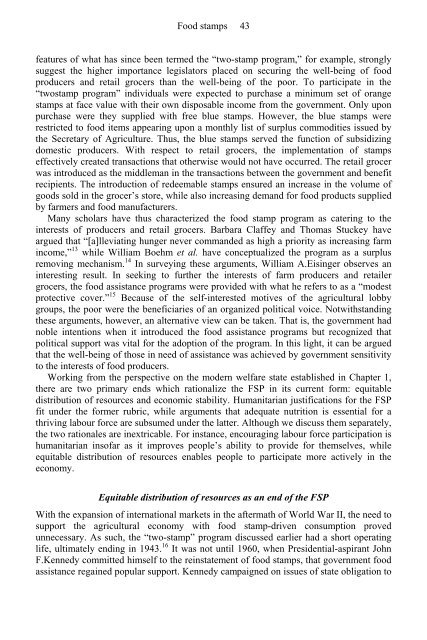Rethinking the Welfare State: The prospects for ... - e-Library
Rethinking the Welfare State: The prospects for ... - e-Library
Rethinking the Welfare State: The prospects for ... - e-Library
Create successful ePaper yourself
Turn your PDF publications into a flip-book with our unique Google optimized e-Paper software.
Food stamps 43<br />
features of what has since been termed <strong>the</strong> “two-stamp program,” <strong>for</strong> example, strongly<br />
suggest <strong>the</strong> higher importance legislators placed on securing <strong>the</strong> well-being of food<br />
producers and retail grocers than <strong>the</strong> well-being of <strong>the</strong> poor. To participate in <strong>the</strong><br />
“twostamp program” individuals were expected to purchase a minimum set of orange<br />
stamps at face value with <strong>the</strong>ir own disposable income from <strong>the</strong> government. Only upon<br />
purchase were <strong>the</strong>y supplied with free blue stamps. However, <strong>the</strong> blue stamps were<br />
restricted to food items appearing upon a monthly list of surplus commodities issued by<br />
<strong>the</strong> Secretary of Agriculture. Thus, <strong>the</strong> blue stamps served <strong>the</strong> function of subsidizing<br />
domestic producers. With respect to retail grocers, <strong>the</strong> implementation of stamps<br />
effectively created transactions that o<strong>the</strong>rwise would not have occurred. <strong>The</strong> retail grocer<br />
was introduced as <strong>the</strong> middleman in <strong>the</strong> transactions between <strong>the</strong> government and benefit<br />
recipients. <strong>The</strong> introduction of redeemable stamps ensured an increase in <strong>the</strong> volume of<br />
goods sold in <strong>the</strong> grocer’s store, while also increasing demand <strong>for</strong> food products supplied<br />
by farmers and food manufacturers.<br />
Many scholars have thus characterized <strong>the</strong> food stamp program as catering to <strong>the</strong><br />
interests of producers and retail grocers. Barbara Claffey and Thomas Stuckey have<br />
argued that “[a]lleviating hunger never commanded as high a priority as increasing farm<br />
income,” 13 while William Boehm et al. have conceptualized <strong>the</strong> program as a surplus<br />
removing mechanism. 14 In surveying <strong>the</strong>se arguments, William A.Eisinger observes an<br />
interesting result. In seeking to fur<strong>the</strong>r <strong>the</strong> interests of farm producers and retailer<br />
grocers, <strong>the</strong> food assistance programs were provided with what he refers to as a “modest<br />
protective cover.” 15 Because of <strong>the</strong> self-interested motives of <strong>the</strong> agricultural lobby<br />
groups, <strong>the</strong> poor were <strong>the</strong> beneficiaries of an organized political voice. Notwithstanding<br />
<strong>the</strong>se arguments, however, an alternative view can be taken. That is, <strong>the</strong> government had<br />
noble intentions when it introduced <strong>the</strong> food assistance programs but recognized that<br />
political support was vital <strong>for</strong> <strong>the</strong> adoption of <strong>the</strong> program. In this light, it can be argued<br />
that <strong>the</strong> well-being of those in need of assistance was achieved by government sensitivity<br />
to <strong>the</strong> interests of food producers.<br />
Working from <strong>the</strong> perspective on <strong>the</strong> modern welfare state established in Chapter 1,<br />
<strong>the</strong>re are two primary ends which rationalize <strong>the</strong> FSP in its current <strong>for</strong>m: equitable<br />
distribution of resources and economic stability. Humanitarian justifications <strong>for</strong> <strong>the</strong> FSP<br />
fit under <strong>the</strong> <strong>for</strong>mer rubric, while arguments that adequate nutrition is essential <strong>for</strong> a<br />
thriving labour <strong>for</strong>ce are subsumed under <strong>the</strong> latter. Although we discuss <strong>the</strong>m separately,<br />
<strong>the</strong> two rationales are inextricable. For instance, encouraging labour <strong>for</strong>ce participation is<br />
humanitarian insofar as it improves people’s ability to provide <strong>for</strong> <strong>the</strong>mselves, while<br />
equitable distribution of resources enables people to participate more actively in <strong>the</strong><br />
economy.<br />
Equitable distribution of resources as an end of <strong>the</strong> FSP<br />
With <strong>the</strong> expansion of international markets in <strong>the</strong> aftermath of World War II, <strong>the</strong> need to<br />
support <strong>the</strong> agricultural economy with food stamp-driven consumption proved<br />
unnecessary. As such, <strong>the</strong> “two-stamp” program discussed earlier had a short operating<br />
life, ultimately ending in 1943. 16 It was not until 1960, when Presidential-aspirant John<br />
F.Kennedy committed himself to <strong>the</strong> reinstatement of food stamps, that government food<br />
assistance regained popular support. Kennedy campaigned on issues of state obligation to


